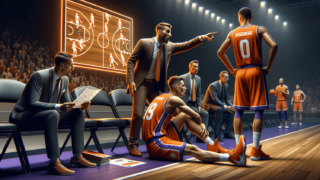
Calling all basketball enthusiasts! 🏀 Have you ever wondered how a well-executed 2-1-1 zone defense can stifle an opponent’s offense and turn the tide of a game? If your curiosity is piqued, then you’re in the right place. In this blog post, we’ll delve into the intricacies of this captivating defensive scheme, breaking down its components and explaining why it’s such an effective weapon in a coach’s strategic arsenal. So, lace up your sneakers and let’s dive into the fascinating world of the 2-1-1 zone defense in basketball!
What’s a 2-1-1 Zone Defense in Basketball?
A 2-1-1 zone defense in basketball is a strategic defensive alignment that consists of two players in the frontcourt, one in the midcourt, and two in the backcourt. This formation aims to pressure ball handlers, limit passing lanes, and disrupt the opposing team’s offensive flow, forcing them into low-percentage shots or turnovers. The 2-1-1 structure encourages teamwork and quick rotations as each player is responsible for a designated area of the court, rather than guarding a specific opponent.
The Strategic Placement of Players in the 2-1-1 Zone Defense
The success of a 2-1-1 zone defense starts with the proper placement of the players on the court. The unique alignment of this zone defense is designed to put pressure on the opposing team’s offensive strategy while providing a solid defensive backbone. Here’s a breakdown of each player’s position and responsibilities:
Frontcourt:
In the 2-1-1 zone defense, the frontcourt players are the initial line of defense. These two players, usually the small forward and power forward, are positioned near the top of the key, their responsibilities being to pressure the ball handlers and limit the passing lanes to the wings.
Midcourt:
The midcourt player, typically the point guard, is situated around the middle of the court. Their primary role in this defense is to anticipate and intercept passes, while also applying pressure to the ball handlers, aiding the frontcourt players. As the ‘middle man’ in this formation, they should have excellent vision, quickness, and communication skills.
Backcourt:
The backcourt players in a 2-1-1 zone defense are usually the shooting guard and center. Their primary responsibility lies in denying the opposing team easy points in the paint and securing defensive rebounds. They also provide essential help defense against dribble penetration and cover passing lanes to low post players.
Taking The Opponent Out of Their Offensive Rhythm
The 2-1-1 zone defense shines in its ability to force the opposing team out of their usual offensive patterns. By effectively pressuring ball handlers, limiting passing lanes, and denying easy shots, this defensive scheme aims to create uncertainty and frustration for the opponent. Here are some key aspects that contribute to the 2-1-1 zone defense’s success:
Forcing Low-Percentage Shots:
The positioning and movement of the players in this zone defense are meticulously designed to limit the opponent’s open looks at the basket. By denying high-percentage shots, the rival team is forced to settle for lower-percentage attempts from the perimeter or contested shots in the paint.
Generating Turnovers:
The 2-1-1 zone defense is geared towards generating turnovers by aggressively pressuring the ball handler and filling passing lanes. With frontcourt players actively pursuing the ball and midcourt players ready to intercept passes, the opposing team is prone to make mistakes, resulting in steals and deflections that lead to easy fast-break opportunities.
Disrupting the Opponent’s Passes:
Quick rotations and excellent court coverage are essential features of the 2-1-1 zone defense, making it difficult for the opposing team to execute their offensive game plan. The constant pressure applied by the frontcourt and midcourt players interrupts the natural flow of the opponent’s passing, eventually leading to turnovers or sub-optimal shot selection.
Mastering the Art of Communication and Rotation
An efficient 2-1-1 zone defense relies heavily on good communication and rotations among the players. As the players guard specific areas of the court instead of man-to-man assignments, teamwork becomes crucial to achieving success.
Maintaining Active Communication:
Effective communication is key to a well-orchestrated 2-1-1 zone defense. The players must constantly exchange information about passing lanes, opposing players’ movements, and potential threats. Proper communication ensures smooth transitions and rotations, preventing any lapses in the defense.
Quick and Accurate Rotations:
In the 2-1-1 zone defense, players are tasked with guarding a designated area of the court. As the opposing team moves the ball around, players must rotate accordingly to maintain the integrity of the defense. A successful 2-1-1 zone defense requires quick, decisive rotations that prevent the rival team from finding open passing lanes or getting clean looks at the basket.
Additional Defensive Strategies Within the 2-1-1 Zone Defense
While the core 2-1-1 zone defensive structure has many benefits, coaches can make strategic adjustments to counter specific offensive threats. Here are some common adaptations and how they can help enhance the 2-1-1 zone defense:
Trapping:
Incorporating traps into the 2-1-1 zone defense can catch the opposing team off guard and further increase the likelihood of turnovers. Frontcourt players can surprise the ball handlers with double teams, forcing them to either make a risky pass, dribble out of the trap, or call a timeout. When done correctly, trapping can lead to steals for the midcourt defender, making the 2-1-1 zone defense even more effective.
Defending Pick and Rolls:
The pick and roll is an offensive staple in basketball, requiring quick thinking and communication to guard effectively. In the 2-1-1 zone defense, players can either hedge, switch, or even double-team the ball handler to neutralize the pick and roll. Each strategy is contingent on the players’ familiarity and understanding, calling for good communication and teamwork.
Zone Press:
Integrating a zone press into the 2-1-1 zone defense can enhance the pressure on the rival team, making it even harder for them to advance the ball across the court. By extending the defense to meet the ball handler in the backcourt, a zone press can force the opponent into hurried decision-making, ultimately yielding turnovers and maintaining defensive dominance.
Cracking the Code of the 2-1-1 Zone Defense from an Offensive Standpoint
Developing an effective counter-strategy against the 2-1-1 zone defense requires a combination of quick ball movement, exploiting gaps, and accurate shooting. Here are some tactics the offensive team can use to break down this otherwise formidable defense:
Quick Ball Movement:
A key factor to dismantling the 2-1-1 zone defense is rapidly moving the basketball from one player to another. By quickly passing the ball, the offensive team can force the defense to scramble, creating mismatches or brief openings for high-quality shot opportunities.
Exploiting Gaps:
As the players move around in their defensive structure, the 2-1-1 zone defense occasionally reveals gaps or seams. Offensive players must identify and exploit these openings, either by penetrating with the dribble or executing well-timed passes to teammates for open shots.
Sharp Shooting:
Shooting accuracy is essential when facing the 2-1-1 zone defense. Knocking down open shots from the perimeter or the mid-range can stretch the defense, forcing them to guard the shooters more closely. Consequently, this creates driving lanes for other players, breaking down the defensive structure and generating high-percentage scoring chances.
Conclusion
The 2-1-1 zone defense is an effective and versatile defensive scheme in the game of basketball. With its emphasis on pressuring ball handlers, disrupting passing lanes, and forcing the opponent into undesirable shot situations, it provides coaches and players an efficient means of stifling the rival’s offense. By mastering communication, rotations, and strategic adjustments, a well-executed 2-1-1 zone defense can prove to be an invaluable asset on the road to victory.
Transitioning from 2-1-1 Zone Defense to Fast-Break Offense
One of the unique advantages of the 2-1-1 zone defense is its ability to seamlessly transition into a fast-break offense. By creating turnovers and securing defensive rebounds, the 2-1-1 zone defense sets up a fluid, explosive offense that can catch the opposing team off guard. Here are some tips on how to turn your rock-solid defense into a lightning-fast offense:
Push the Tempo:
As soon as the players in the 2-1-1 zone defense have disrupted the opposing team’s offense, secured a turnover, or collected a rebound, they should look for opportunities to push the ball up the court quickly. Catching the rival off-guard during this transition can lead to high-percentage scoring opportunities such as layups and open jump shots.
Effective Passing in Transition:
For a smooth transition from defense to offense, the players must develop effective passing habits. This includes making accurate outlet passes to the right teammates, ensuring that the ball advances up the court rapidly. Players should also be mindful not to force any passes, as this may lead to turnovers and the potential loss of an offensive advantage.
Spacing and Timing:
Proper spacing and timing are crucial in executing an effective fast-break offense after the 2-1-1 zone disruption. Each player should sprint to their designated position on the court, filling the lanes and giving the ball handler multiple attacking options. Spacing also helps when breaking down the retreating defense and creates opportunities for uncontested perimeter shots.
When to Deploy the 2-1-1 Zone Defense
Knowing when to employ the 2-1-1 zone defense is an essential aspect of maximizing its effectiveness. In some game situations, this defensive scheme will prove to be more useful than others. Here are some scenarios in which the 2-1-1 zone defense shines:
Against Non-Shooting Teams:
If the opposing team lacks strong perimeter shooters, the 2-1-1 zone defense can be a powerful tool to limit their scoring options. By focusing on denying paint shots and forcing the rival team to attempt outside shots, the 2-1-1 zone defense can exploit their weakness and make scoring more difficult.
Containing Dominant Guards:
When facing a team with exceptionally skilled guards, employing the 2-1-1 zone defense can help to minimize their offensive impact. Due to the frontcourt players’ constant pressure on the ball and the midcourt player’s role in intercepting passes, this defensive scheme can effectively limit the guards’ ability to create plays for their team and force them into unfavorable situations.
To Protect Players in Foul Trouble:
If key players on your team are in foul trouble, the 2-1-1 zone defense can provide a more protective defensive option. With its emphasis on guarding specific areas of the court and not individual players, the likelihood of drawing additional fouls is minimized, thus conserving your essential players for the remainder of the game.
FAQs: 2-1-1 Zone Defense Basketball Queries Answered
Want some quick answers to frequently asked questions about the 2-1-1 zone defense in basketball? You can now satisfy the most common queries right here, in our convenient FAQ section. Get ready to brush up on this fascinating defensive strategy and enhance your basketball expertise with these concise responses.
1. How does the 2-1-1 Zone Defense compare to the famous 2-3 Zone Defense?
The 2-1-1 zone defense emphasizes applying pressure on ball handlers and passing lanes in the frontcourt, whereas the 2-3 zone defense focuses on protecting the paint and closing out the perimeter. Both have their strengths, but the 2-1-1 zone defense tends to be more aggressive, generating more turnovers than the 2-3 zone defense.
2. Can the 2-1-1 Zone Defense work against taller or faster opponents?
Yes, the 2-1-1 zone defense can be effective against taller or faster opponents, as it focuses on disrupting the opposing team’s offense rather than isolating individual player matchups. By pressuring ball handlers and filling passing lanes, the 2-1-1 zone defense neutralizes height and speed advantages.
3. Is the 2-1-1 Zone Defense suitable for youth basketball teams?
Absolutely! The 2-1-1 zone defense is a versatile and effective strategy for youth basketball teams. It teaches players the essentials of teamwork, communication, and spatial awareness, while simultaneously providing a sturdy defensive framework.
4. How can teams with excellent shooters counter the 2-1-1 Zone Defense?
To counter the 2-1-1 zone defense, teams with strong shooters should focus on quick ball movement, finding gaps in the defense, and knocking down open perimeter shots consistently. This strategy stretches the defense, forcing them to guard the shooters more closely, which opens driving lanes and additional scoring opportunities.
5. Do we need specialized players in a team to execute a 2-1-1 Zone Defense?
While not specifically required, having versatile players with unique skill sets will improve the performance of a 2-1-1 zone defense. Good communication, court awareness, and defensive instincts contribute significantly to the success of this defensive strategy.
6. How do teams prevent getting out-rebounded when playing a 2-1-1 Zone Defense?
Despite the emphasis on applying pressure and intercepting passes, the 2-1-1 zone defense requires all players to rebound the basketball. When a shot goes up, players must locate their nearest opponent, box them out, and secure the rebound, ensuring that the team doesn’t get out-rebounded.
7. Is the 2-1-1 Zone Defense only effective on a full-court press?
No, the 2-1-1 zone defense is effective both as a full-court press and a half-court defense. In a full-court press scenario, the defense applies pressure from the baseline, whereas in a half-court scenario, it picks up when the opposing team crosses midcourt.
8. Can the 2-1-1 Zone Defense be employed throughout an entire game?
Yes, it is possible to employ the 2-1-1 zone defense throughout an entire game. However, it’s essential to analyze the opposing team’s adjustments and offensive strategies to maintain the defense’s effectiveness. Mixing it up with other defensive alignments can also help to keep the rival team off balance.
9. How to prevent opponents from exploiting the baseline or corners in a 2-1-1 Zone Defense?
Quick rotations and communication are key to preventing opponents from exploiting the baseline or corners in the 2-1-1 zone defense. Players must be aware of the ball’s position and the opposing players’ movements, swiftly rotating and adjusting their positions to maintain the integrity of the defense.
10. How can I practice the 2-1-1 Zone Defense with my team?
To practice the 2-1-1 zone defense with your team, start by emphasizing proper positioning, communication, and rotations within the defensive structure. Conduct drills focused on intercepting passes, applying pressure, and executing quick rotations. Scrimmages against different offensive strategies can also help fine-tune the defense and prepare the team for real-game situations.
Featured Posts
- No pillar pages found.





